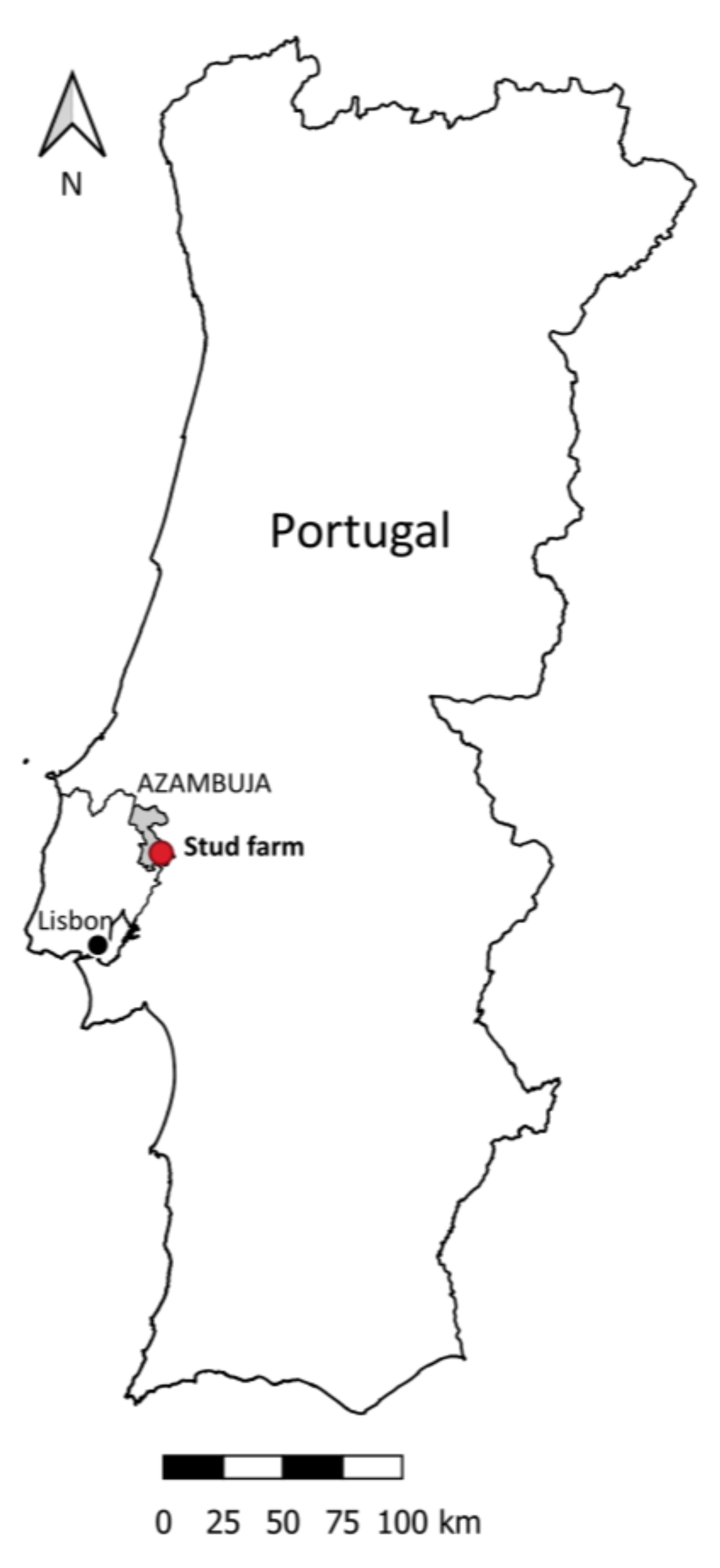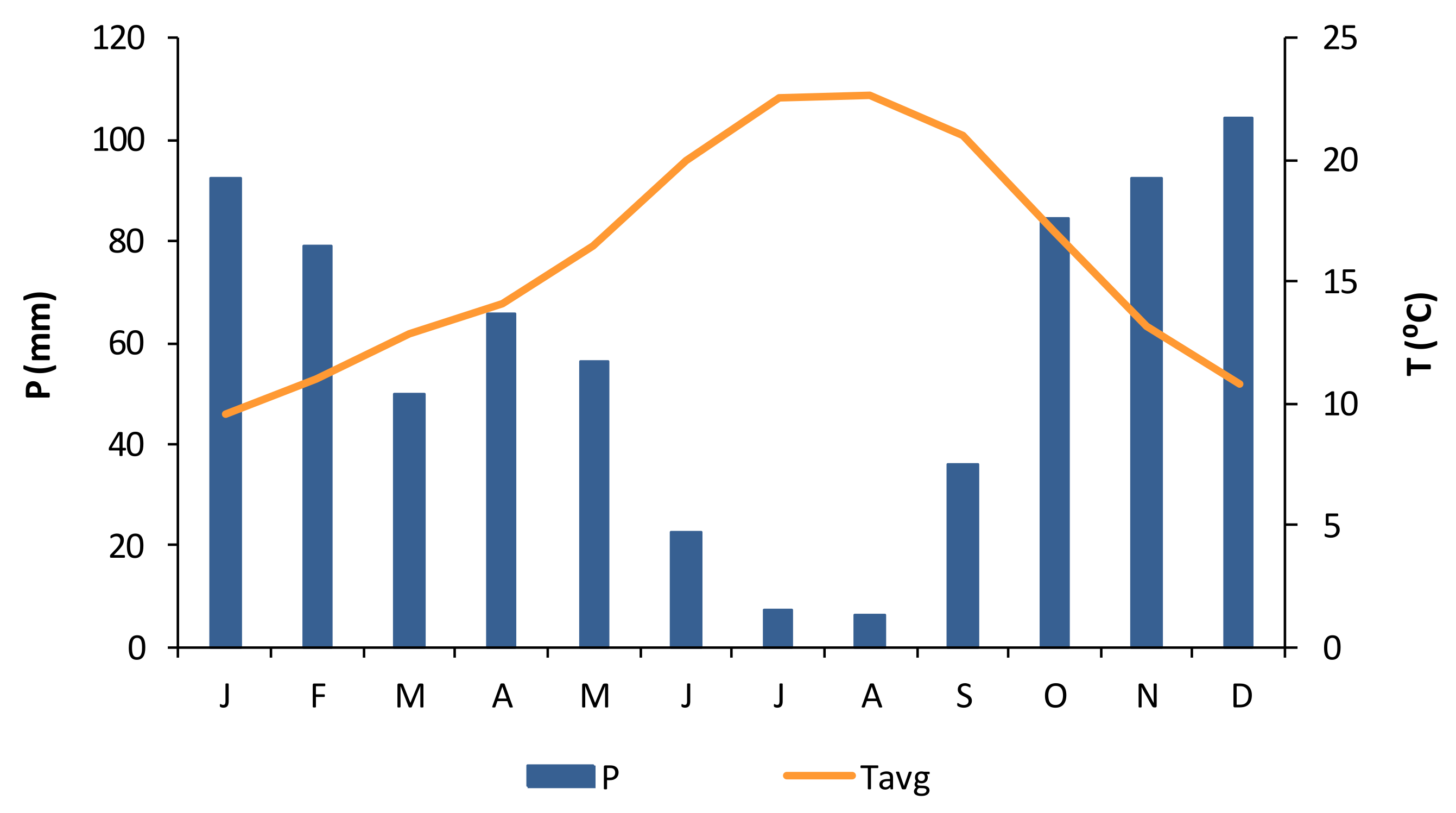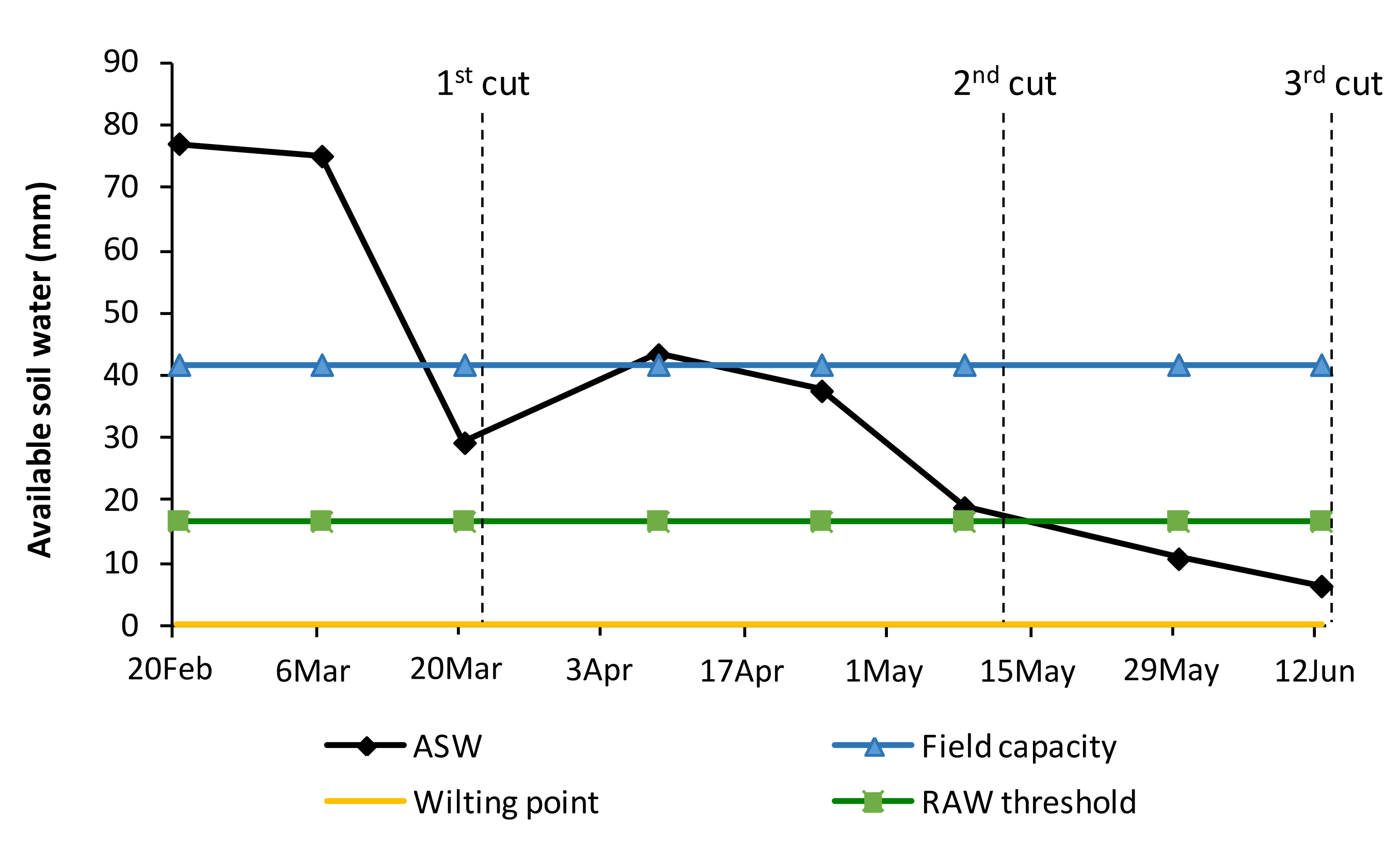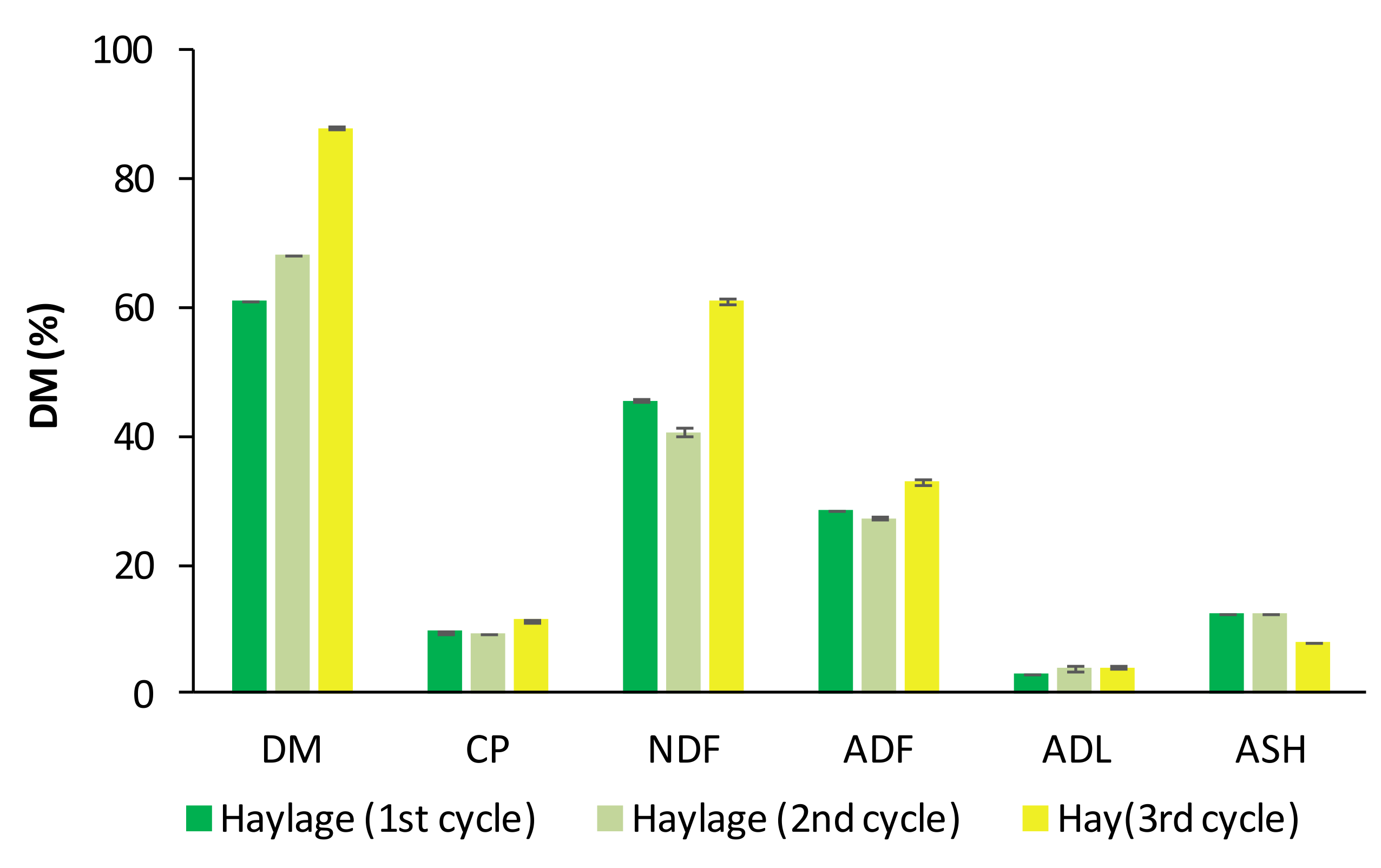Production of Preserved Forage for Horses under Water Scarcity Conditions: A Case Study
Abstract
:1. Introduction
2. Materials and Methods
2.1. Description of the Study Area
2.2. Climate
2.3. Soil
2.4. Forage
2.5. Forage Sampling
2.6. Forage Productivity
2.7. Forage Chemical Analysis
2.8. Data Analysis
3. Results and Discussion
3.1. Floristic Composition
3.2. Soil Water Content
3.3. Forage Productivity
3.4. Forage Chemical Composition
3.4.1. Green Forage
3.4.2. Preserved Forage
3.4.3. Nutritional Value
4. Conclusions
Author Contributions
Funding
Institutional Review Board Statement
Informed Consent Statement
Data Availability Statement
Acknowledgments
Conflicts of Interest
References
- Harris, P.A.; Ellis, A.D.; Fradinho, M.J.; Jansson, A.; Julliand, V.; Luthersson, N.; Santos, A.S.; Vervuert, I. Feeding conserved forage to horses: Recent advances and recommendations. Animal 2017, 11, 958–967. [Google Scholar] [CrossRef] [PubMed] [Green Version]
- Piscitelli, L.; Colovic, M.; Aly, A.; Hamze, M.; Todorovic, M.; Cantore, V.; Albrizio, R. Adaptive AGRICULTURAL Strategies for Facing Water Deficit in Sweet Maize Production: A Case Study of a Semi-Arid Mediterranean Region. Water 2021, 13, 3285. [Google Scholar] [CrossRef]
- Van Soest, P.J.; Robertson, J.B.; Lewis, B.A. Methods for dietary fiber, neutral detergent fiber, and nonstarch polysaccharides in relation to animal nutrition. J. Dairy Sci. 1991, 74, 3583–3597. [Google Scholar] [CrossRef]
- Virkajärvi, P.; Järvenranta, K.; Rinne, M.; Saastamoinen, M. Grass physiology and its relation to nutritive value in feeding horses. In Forages and Grazing in Horse Nutrition; Saastamoinen, M., Fradinho, M.J., Santos, A.S., Miraglia, N., Eds.; Wageningen Academic Publishers: Wageningen, The Netherlands, 2012; pp. 17–43. [Google Scholar] [CrossRef]
- Müller, C.E. Silage and haylage for horses. Grass Forage Sci. 2018, 73, 815–827. [Google Scholar] [CrossRef]
- Martin-Rosset, W. Equine Nutrition: INRA Nutrient Requirements, Recommended Allowances and Feed Tables; Wageningen Academic Publishers: Wageningen, The Netherlands, 2015; p. 696. [Google Scholar] [CrossRef]
- Abreu, M.; Bruno-Sores, M.; Fátima, C. Intake and Nutritive Value of Mediterranean Forages & Diets: 20 Years of Experimental Data; ISA Press: Lisbon, Portugal, 2000. [Google Scholar]
- Moreira, N. Agronomia das Forragens e Pastagens; UTAD: Vila Real, Portugal, 2002; p. 183. [Google Scholar]
- Miranda, P.M.; Cardoso, R.M.; Soares, P.M.M.; Valente, M.A.; Viterbo, P.A. Mudança Climática. In Cultivar. Cadernos de Análise e Prospective; Gabinete de Planeamento, Políticas e Administração Gera: Lisbon, Portugal, 2018; Volume 12, pp. 29–37. [Google Scholar]
- Pires, V.; Cota, T.M.; Silva, A. Observações Alteradas no Clima Atual e Cenários Climáticos em Portugal Continental-Influência no Setor Agrícola. In Cultivar. Cadernos de Análise e Prospective; Gabinete de Planeamento, Políticas e Administração Gera: Lisbon, Portugal, 2018; Volume 12, pp. 57–67. [Google Scholar]
- Djaman, K.; Smeal, D.; Koudahe, K.; Allen, S. Hay Yield and Water Use Efficiency of Alfalfa under Different Irrigation and Fungicide Regimes in a Semiarid Climate. Water 2020, 12, 1721. [Google Scholar] [CrossRef]
- Mendoza-Grimón, V.; Hernández-Moreno, J.M.; Palacios-Díaz, M.D.P. Improving Water Use in Fodder Production. Water 2015, 7, 2612–2621. [Google Scholar] [CrossRef]
- Carvalho, A.A.d.; Montenegro, A.A.d.A.; de Lima, J.L.M.P.; Silva, T.G.F.d.; Pedrosa, E.M.R.; Almeida, T.A.B. Coupling Water Resources and Agricultural Practices for Sorghum in a Semiarid Environment. Water 2021, 13, 2288. [Google Scholar] [CrossRef]
- Ergon, A.; Seddain, G.; Korhonen, P.; Virkajarvi, P.; Bellocchi, G.; Jorgensen, M.; Ostrem, L.; Reheul, D.; Volaire, F. How can forage production in Nordic and Mediterranean Europe adapt to challenges and opportunities arising from climate change? Eur. J. Agron. 2018, 92, 97–106. [Google Scholar] [CrossRef] [Green Version]
- Dumont, B.; Andueza, D.; Niderkorn, V.; Lüscher, A.; Porqueddu, C.; Picon-Cochard, C. A meta-analysis of climate change effects on forage quality in grasslands: Specificities of mountain and Mediterranean areas. Grass Forage Sci. 2015, 70, 239–254. [Google Scholar] [CrossRef]
- Rolim, J.; Teixeira, J.L.; Catalão, J.; Shahidian, S. The impacts of climate change on irrigated agriculture in southern Portugal. Irrig. Drain. 2017, 66, 3–18. [Google Scholar] [CrossRef]
- Mclennon, E.; Solomon, J.K.Q.; Davison, J. Grass–Legume Forage Systems Effect on Phosphorus Removal from a Grassland Historically Irrigated with Reclaimed Wastewater. Sustainability 2002, 12, 2256. [Google Scholar] [CrossRef] [Green Version]
- Soares, D.; Rolim, J.; Fradinho, M.J.; Paço, T.A.D. Climate Change Impacts on Irrigation Requirements of Preserved Forage for Horses under Mediterranean Conditions. Agronomy 2020, 10, 1758. [Google Scholar] [CrossRef]
- Beck, H.E.; Zimmermann, N.E.; McVicar, T.; Vergopolan, N.; Berg, A.; Wood, E.F. Present and future Köppen-Geiger climate classification maps at 1-km resolution. Sci. Data 2018, 5, 180214. [Google Scholar] [CrossRef] [PubMed] [Green Version]
- FAO. World Reference Base for Soil Resources 2014. International Soil Classification System for Naming Soils and Creating Legends for Soil Maps—Update 2015; World Soil Resources Reports No. 106; FAO: Rome, Italy, 2015; p. 192. [Google Scholar]
- Artiola, J.F.; Walworth, J.L.; Musil, S.A.; Crimmins, M.A. Soil and Land Pollution. In Environmental and Pollution, 3rd ed.; Brusseau, M.L., Pepper, I.L., Gerba, C.P., Eds.; Elsevier: London, UK, 2019; pp. 219–235. [Google Scholar] [CrossRef]
- Cardoso, J.V.J.C. Os Solos de Portugal. Sua Classificação, Caracterização e Génese; Secretaria de Estado da Agricultura, Direcção-Geral dos Serviços Agrícolas: Lisbon, Portugal, 1965; p. 310.
- Reynolds, S.G. The gravimetric method of soil moisture determination Part IA study of equipment, and methodological problems. J. Hydrol. 1970, 11, 258–273. [Google Scholar] [CrossRef]
- McDonald, P.; Edwards, R.A.; Greenhalg, J.F.D.; Morgan, C.A. Animal Nutrition, 6th ed.; Pearson Education: Harlow, UK, 2002. [Google Scholar]
- Mitchell, K.J.; Glenday, A.C. The tiller population of pastures. N. Z. J. Agric. Res. 1958, 1, 305–318. [Google Scholar] [CrossRef]
- Cayley, J.W.D.; Bird, P.R. Techniques for Measuring Pastures; Department of Agriculture technical report series no. 191; Victoria Department of Agriculture, Pastoral and Veterinary Institute Hamilton: Victoria, Australia, 1996; p. 51.
- Falcão-e-Cunha, L.; Peres, H.; Freire, J.P.B.; Castro-Solla, L. Effects of alfalfa, wheat bran or beet pulp, with or without sunflower oil, on caecal fermentation and on digestibility in the rabbit. Anim. Feed. Sci. Technol. 2004, 117, 131–149. [Google Scholar] [CrossRef]
- Thiex, N.J.; Manson, H.; Anderson, S.; Persson, J.-Å. Determination of crude protein in animal feed, forage, grain, and oilseeds by using block digestion with a copper catalyst and steam distillation into boric acid: Collaborative study. J. AOAC Int. 2002, 85, 309–317. [Google Scholar] [CrossRef] [PubMed] [Green Version]
- Allen, R.G.; Pereira, L.S.; Raes, D.; Smith, M. Crop Evapotranspiration. Guidelines for Computing Crop Water Requirements; FAO Irrigation and Drainage Paper 56; FAO: Rome, Italy, 2008; p. 300. [Google Scholar]
- Lopes, V.; Nogueira, A.; Fernandes, A. Ficha Técnica 53—Cultura do Azevém Anual. Available online: http://www.drapn.minagricultura.pt/drapn/conteudos/FICHAS_DRAEDM/Ficha_tecnica_053_2006.pdf (accessed on 13 June 2020).
- Müller, C.E. Equine digestion of diets based on haylage harvested at different plant maturities. Anim. Feed. Sci. Technol. 2012, 177, 65–74. [Google Scholar] [CrossRef]
- Bijelić, Z.; Tomić, Z.; Ružić-Muslić, D. The effect of nitrogen fertilization on production and qualitative properties of sown grasslands in the system of sustainable production. Biotechnol. Anim. Husb. 2011, 27, 615–630. [Google Scholar] [CrossRef]
- Freixial, R.; Alpendre, P. Conservação de Forragens-Fenação; Universidade de Évora: Évora, Portugal, 2013; p. 38. [Google Scholar]






| Month | Tmin (°C) | Tmax (°C) | Tavg (°C) | P (mm) | ETo (mm d−1) |
|---|---|---|---|---|---|
| October/2018 | 11 | 24.2 | 17.3 | 85.7 | 3.1 |
| November/2018 | 8.9 | 17.3 | 12.8 | 143.2 | 1.5 |
| December/2018 | 5.9 | 16.1 | 10.5 | 49 | 1.4 |
| January/2019 | 3.3 | 14.8 | 8.3 | 29.5 | 1.4 |
| February/2019 | 4.9 | 17.9 | 10.8 | 70.8 | 2.3 |
| March/2019 | 6.6 | 20.6 | 13.3 | 44.1 | 3.4 |
| April/20198 | 8.7 | 19.3 | 13.8 | 64.8 | 3.8 |
| May/2019 | 12.1 | 26.5 | 19 | 0 | 5.8 |
| June/2019 | 12.6 | 24.9 | 18.8 | 7.2 | 5.5 |
| 1st (Haylage) | 2nd (Haylage) | 3rd (Hay) | SEM | p-Value | |
|---|---|---|---|---|---|
| DM | 141.8 a | 169.8 b | 244.8 c | 7.3 | <0.0001 |
| OM | 888.6 a | 892.3 a | 921.1 b | 4.8 | <0.001 |
| CP | 115.6 | 109.3 | 128.8 | 9.0 | 0.316 |
| NDF | 453.4 a | 505.5 b | 605.1 c | 10.6 | <0.0001 |
| ADF | 271.1 a | 270.1 a | 314.1 b | 6.8 | <0.001 |
| ADL | 34.9 a | 33.9 a | 44.6 b | 2.1 | <0.01 |
| Ash | 111.4 a | 107.8 a | 78.9 b | 4.8 | <0.001 |
| Preserved Forage | UFC/kg DM | MADC (g/kg DM) |
|---|---|---|
| Haylage 1st harvest | 0.65 | 45.96 |
| Haylage 2nd harvest | 0.66 | 43.74 |
| Hay 3rd harvest | 0.57 | 56.65 |
Publisher’s Note: MDPI stays neutral with regard to jurisdictional claims in published maps and institutional affiliations. |
© 2022 by the authors. Licensee MDPI, Basel, Switzerland. This article is an open access article distributed under the terms and conditions of the Creative Commons Attribution (CC BY) license (https://creativecommons.org/licenses/by/4.0/).
Share and Cite
Soares, D.; Rolim, J.; Fradinho, M.J.; do Paço, T.A. Production of Preserved Forage for Horses under Water Scarcity Conditions: A Case Study. Water 2022, 14, 388. https://doi.org/10.3390/w14030388
Soares D, Rolim J, Fradinho MJ, do Paço TA. Production of Preserved Forage for Horses under Water Scarcity Conditions: A Case Study. Water. 2022; 14(3):388. https://doi.org/10.3390/w14030388
Chicago/Turabian StyleSoares, Daniela, João Rolim, Maria João Fradinho, and Teresa Afonso do Paço. 2022. "Production of Preserved Forage for Horses under Water Scarcity Conditions: A Case Study" Water 14, no. 3: 388. https://doi.org/10.3390/w14030388
APA StyleSoares, D., Rolim, J., Fradinho, M. J., & do Paço, T. A. (2022). Production of Preserved Forage for Horses under Water Scarcity Conditions: A Case Study. Water, 14(3), 388. https://doi.org/10.3390/w14030388









